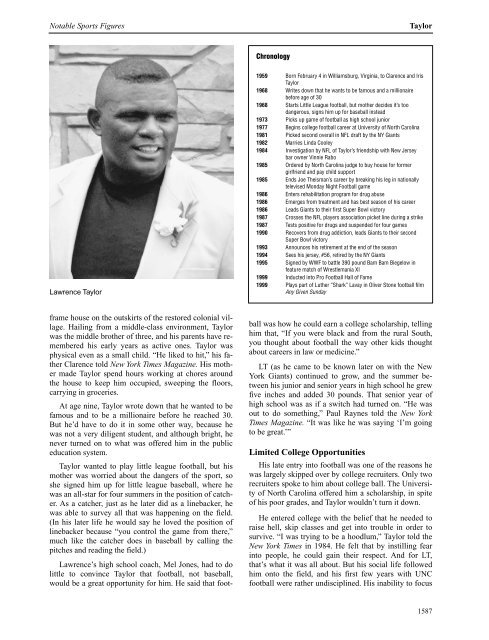Frank Thomas
Frank Thomas
Frank Thomas
You also want an ePaper? Increase the reach of your titles
YUMPU automatically turns print PDFs into web optimized ePapers that Google loves.
Notable Sports Figures<br />
Lawrence Taylor<br />
frame house on the outskirts of the restored colonial village.<br />
Hailing from a middle-class environment, Taylor<br />
was the middle brother of three, and his parents have remembered<br />
his early years as active ones. Taylor was<br />
physical even as a small child. “He liked to hit,” his father<br />
Clarence told New York Times Magazine. His mother<br />
made Taylor spend hours working at chores around<br />
the house to keep him occupied, sweeping the floors,<br />
carrying in groceries.<br />
At age nine, Taylor wrote down that he wanted to be<br />
famous and to be a millionaire before he reached 30.<br />
But he’d have to do it in some other way, because he<br />
was not a very diligent student, and although bright, he<br />
never turned on to what was offered him in the public<br />
education system.<br />
Taylor wanted to play little league football, but his<br />
mother was worried about the dangers of the sport, so<br />
she signed him up for little league baseball, where he<br />
was an all-star for four summers in the position of catcher.<br />
As a catcher, just as he later did as a linebacker, he<br />
was able to survey all that was happening on the field.<br />
(In his later life he would say he loved the position of<br />
linebacker because “you control the game from there,”<br />
much like the catcher does in baseball by calling the<br />
pitches and reading the field.)<br />
Lawrence’s high school coach, Mel Jones, had to do<br />
little to convince Taylor that football, not baseball,<br />
would be a great opportunity for him. He said that foot-<br />
Chronology<br />
Taylor<br />
1959 Born February 4 in Williamsburg, Virginia, to Clarence and Iris<br />
Taylor<br />
1968 Writes down that he wants to be famous and a millionaire<br />
before age of 30<br />
1968 Starts Little League football, but mother decides it’s too<br />
dangerous, signs him up for baseball instead<br />
1973 Picks up game of football as high school junior<br />
1977 Begins college football career at University of North Carolina<br />
1981 Picked second overall in NFL draft by the NY Giants<br />
1982 Marries Linda Cooley<br />
1984 Investigation by NFL of Taylor’s friendship with New Jersey<br />
bar owner Vinnie Rabo<br />
1985 Ordered by North Carolina judge to buy house for former<br />
girlfriend and pay child support<br />
1985 Ends Joe Theisman’s career by breaking his leg in nationally<br />
televised Monday Night Football game<br />
1986 Enters rehabilitation program for drug abuse<br />
1986 Emerges from treatment and has best season of his career<br />
1986 Leads Giants to their first Super Bowl victory<br />
1987 Crosses the NFL players association picket line during a strike<br />
1987 Tests positive for drugs and suspended for four games<br />
1990 Recovers from drug addiction, leads Giants to their second<br />
Super Bowl victory<br />
1993 Announces his retirement at the end of the season<br />
1994 Sees his jersey, #56, retired by the NY Giants<br />
1995 Signed by WWF to battle 390 pound Bam Bam Biegelow in<br />
feature match of Wrestlemania XI<br />
1999 Inducted into Pro Football Hall of Fame<br />
1999 Plays part of Luther “Shark” Lavay in Oliver Stone football film<br />
Any Given Sunday<br />
ball was how he could earn a college scholarship, telling<br />
him that, “If you were black and from the rural South,<br />
you thought about football the way other kids thought<br />
about careers in law or medicine.”<br />
LT (as he came to be known later on with the New<br />
York Giants) continued to grow, and the summer between<br />
his junior and senior years in high school he grew<br />
five inches and added 30 pounds. That senior year of<br />
high school was as if a switch had turned on. “He was<br />
out to do something,” Paul Raynes told the New York<br />
Times Magazine. “It was like he was saying ‘I’m going<br />
to be great.’”<br />
Limited College Opportunities<br />
His late entry into football was one of the reasons he<br />
was largely skipped over by college recruiters. Only two<br />
recruiters spoke to him about college ball. The University<br />
of North Carolina offered him a scholarship, in spite<br />
of his poor grades, and Taylor wouldn’t turn it down.<br />
He entered college with the belief that he needed to<br />
raise hell, skip classes and get into trouble in order to<br />
survive. “I was trying to be a hoodlum,” Taylor told the<br />
New York Times in 1984. He felt that by instilling fear<br />
into people, he could gain their respect. And for LT,<br />
that’s what it was all about. But his social life followed<br />
him onto the field, and his first few years with UNC<br />
football were rather undisciplined. His inability to focus<br />
1587

















